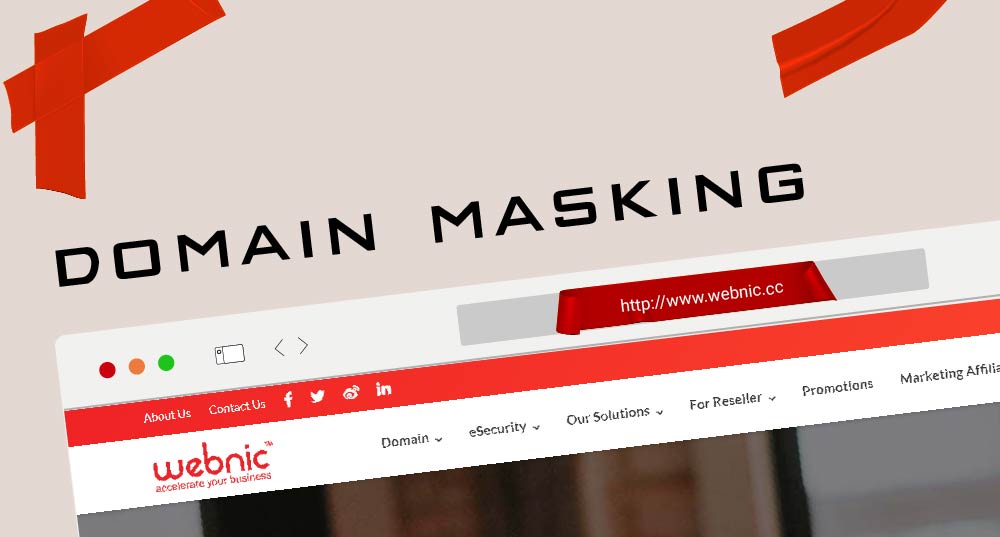What is Domain Masking: Everything you need to know about it
Domain masking, also known as URL masking or domain cloaking, is a technique used to redirect visitors from a domain or subdomain to another website, while keeping the original domain or subdomain in the URL bar. The main purpose of domain masking is to make a website appear to be hosted on a different domain, without changing the underlying website’s URL.

For instance, if your brand or company owns the domain “example.com” and wants to redirect visitors to the main website, which is located at “mainwebsite.com”, they can set up a redirect on the server for “example.com” to “mainwebsite.com”.
When a visitor types in “example.com” in their browser, they will be redirected to “mainwebsite.com”, but the URL in the browser will still show “example.com”. This way, if someone creates a phishing website using your brand’s name, visitors will be directed to your legitimate website instead.
Why Domain Masking: 3 reasons of using and 1 malicious usage to be aware of

In today’s digital age, protecting your brand’s reputation is more important than ever. With the rise of phishing scams and malicious content, it’s crucial to take steps to ensure that your brand is not associated with anything that could harm its reputation. By implementing domain masking, you can protect your brand from being associated with potentially harmful or malicious content.
1. Protect your brand’s reputation
One of the main reasons why people use domain masking is to protect their brand digitally. For example, if a company owns several different domain names, they may want to redirect visitors who type in one of the unused domain names to their main website. This can prevent confusion and ensure that visitors always land on the correct website.
Additionally, it can also be used to hide affiliate links, so that they do not appear to be affiliate links, but instead appear to be part of the website’s main domain.
2. Protecting Privacy
The next use case of domain masking is to protect the privacy of the website owner. Some website owners may not want to reveal their personal or business information on the WHOIS record of their domain name, as it can be accessed by anyone. By using domain masking, the personal or business information is hidden and replaced with the information of the domain masking service provider. This can protect the privacy of the website owner and prevent unwanted contact or spam.
3. Domain Parking
Another use of domain masking is for domain parking. Domain parking is when a domain name is registered, but no website is built on it yet. Instead, the domain is pointed to a “parking page” which may show ads and links related to the domain name. This can be a way for the domain name owner to make some income, as visitors may click on the ads and links on the parking page. By using domain masking, the parking page can be made to appear as if it is part of the domain name, rather than a separate page.
4. Malicious Use

However, it’s important to note that domain masking can also be used for malicious purposes. Some spammers or scammers may use domain masking to hide the true origin of a website or to make a website appear more trustworthy than it actually is.
For this reason, it is important to be cautious when clicking on links from websites that use domain masking and to always verify the authenticity of a website before entering any personal or financial information.
How does Domain Masking work?
This can be done using a redirect in the website’s server or by using an iframe.
Redirects
This is done by configuring the server to redirect all requests for a specific domain or subdomain to another website. For example, a company can redirect visitors from “example.com” to their main website “mainwebsite.com” while keeping the URL as “example.com”
Iframes
Another method to implement domain masking is through the use of an iframe, an HTML element that allows a website to embed another website within its own webpage, while keeping the original domain or subdomain in the URL bar. This method is commonly used by domain parking providers to show ads and links related to the parked domain.
Domain Name Registrar
In most cases, you can use domain masking by contacting your domain registrar and requesting for domain masking. They will provide you with the necessary steps to set it up and point your domain to the desired web page.
What company/ organization needs a Domain Masking?
There are a variety of companies and organizations that may need to use domain masking. Some examples include:
- E-Commerce companies may want to use domain masking to redirect customers to a specific landing page or product page, while keeping the original domain or subdomain in the URL bar.
- Banks & other Financial institutions may want to use domain masking to protect their customers from phishing scams and ensure that they are always directed to the institution’s legitimate website.
- Non-profit organizations (NPO) may want to use domain masking to redirect visitors to a specific campaign or donation page, while keeping the original domain or subdomain in the URL bar.
- Government agencies may use domain masking to protect citizens from phishing scams and ensure that they are always directed to the agency’s legitimate website.
- Educational institutions may want to use domain masking to redirect students and faculty to specific portals or resources, while keeping the original domain or subdomain in the URL bar.
- Marketing agencies may want to use domain masking to redirect visitors to a specific landing page or campaign, while keeping the original domain or subdomain in the URL bar.
- IT companies may want to use domain masking to redirect visitors to specific services or resources, while keeping the original domain or subdomain in the URL bar.
 E-Commerce companies
E-Commerce companies Banks & other Financial institutions
Banks & other Financial institutions Government agencies
Government agencies IT companies
IT companies Marketing agencies
Marketing agencies Non-profit organizations (NPO)
Non-profit organizations (NPO) Banks & other Financial institutions
Banks & other Financial institutions
These are just a few examples of companies and organizations that may need to use domain masking. Ultimately, any company or organization that wants to protect its brand’s reputation and ensure that its visitors are always directed to its legitimate website may want to consider using domain masking.
In summary, it is a useful tool for protecting your brand, domain parking, protecting privacy. It’s important to be cautious when clicking on links from websites that use domain masking and to always verify the authenticity of a website before entering any personal or financial information. To start domain masking today!
Author: Liaw Chan Kang

